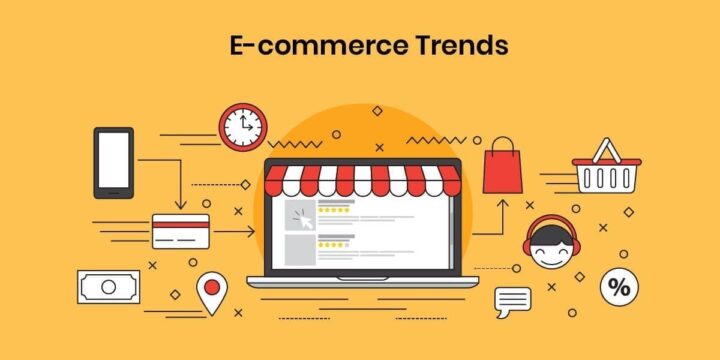Top Trends in eCommerce Development for 2023
In the ever-evolving world of eCommerce, staying ahead of the trends is crucial for success. As we look towards 2023, there are several key trends shaping the future of eCommerce. From the accelerated use of mobile shopping to the rise of artificial intelligence, these trends are set to transform the industry. In this article, we will explore the top trends in eCommerce development for 2023 and discuss how businesses can leverage them to stay competitive in the digital marketplace.
Hyper-Mobile eCommerce
Mobile commerce has been on the rise for the past few years and is expected to continue its growth trajectory in 2023. With more and more people using their smartphones to shop, it's no surprise that mobile shopping will account for nearly three-fourths of all eCommerce sales by 2023. This shift towards mobile commerce has been fueled by the increasing number of retailers offering mobile-optimized websites and apps, making it easier for customers to browse and buy from anywhere.

- However, there are still many eCommerce sites that are not fully optimized for mobile. This presents an opportunity for businesses to develop a robust mobile eCommerce strategy that encompasses every aspect of the online shopping experience, from marketing to sales. By optimizing their sites for mobile devices, businesses can ensure that customers can easily browse and make purchases, regardless of their location.
- To capitalize on the hyper-mobile eCommerce trend, businesses should consider investing in responsive design and mobile app development. Responsive design allows websites to adapt to different screen sizes, ensuring a seamless user experience across devices. Mobile apps, on the other hand, provide a more personalized and immersive shopping experience, allowing businesses to engage with customers on a deeper level.
- Artificial Intelligence (AI) has been a game-changer in various industries, and eCommerce is no exception. AI-powered technologies are already being used by retailers worldwide to automate processes, make data-driven decisions, and provide personalized experiences to shoppers. In 2023, we can expect AI to play an even more significant role in eCommerce development.
- One of the key areas where AI can make a difference is in understanding customer needs and behavior. By analyzing large amounts of data, AI algorithms can identify patterns and trends, allowing businesses to anticipate customer preferences and offer tailored recommendations. This level of personalization can significantly enhance the customer experience and drive higher conversion rates.
- AI can also be leveraged to optimize supply chains and reduce costs. Machine learning algorithms can analyze historical sales data, inventory levels, and other factors to predict demand accurately. This enables businesses to optimize their inventory management and ensure that popular products are always in stock.
- Furthermore, AI-powered chatbots and virtual assistants are becoming increasingly popular in eCommerce. These intelligent bots can provide real-time customer support, answer inquiries, and assist with purchasing decisions. By offering personalized and efficient customer service, businesses can enhance customer satisfaction and drive repeat purchases.
- Social media platforms are no longer just places for socializing and sharing content. They have evolved into powerful eCommerce platforms, where users can discover, browse, and purchase products without leaving the platform. This integration of shopping features within social media platforms, known as social commerce, has gained significant traction and is expected to continue growing in 2023.
- Major social media platforms like Facebook, Instagram, and Pinterest have introduced various shopping features, such as Instagram's Checkout and Facebook's Marketplace. These features enable businesses to showcase their products, provide detailed product information, and facilitate seamless transactions. This integration of social media and eCommerce offers a convenient and frictionless shopping experience for consumers, increasing the likelihood of impulse purchases and driving sales
- To leverage the potential of social commerce, businesses should focus on building a strong social media presence and engaging with their target audience. By sharing visually appealing content, collaborating with influencers, and running targeted ad campaigns, businesses can attract potential customers and drive traffic to their social commerce platforms.
Artificial Intelligence (AI)
Social Commerce
Personalization
- Consumers today expect personalized shopping experiences, and eCommerce retailers are responding by leveraging data analytics and AI to provide tailored recommendations, targeted advertising, and personalized email marketing. In 2023, this trend is expected to continue growing, with businesses using customer data and predictive analytics to create unique and customized shopping experiences.
- One way to implement personalization is through dynamic product recommendations. By analyzing customer browsing and purchase history, businesses can suggest relevant products, increasing the chances of cross-selling and upselling. Personalized recommendations not only enhance the customer experience but also drive higher conversion rates and customer loyalty.
- Additionally, businesses can leverage personalization in their marketing efforts. By segmenting their customer base and delivering targeted marketing campaigns, businesses can deliver tailored messages that resonate with individual customers. This level of personalization helps build stronger connections with customers and increases the likelihood of repeat purchases.
Augmented Reality (AR) and Virtual Reality (VR)
- Augmented Reality (AR) and Virtual Reality (VR) technologies are revolutionizing the way consumers shop online. By providing immersive and interactive experiences, AR and VR technologies enable customers to visualize products in real-world settings, try on clothing virtually, or explore virtual showrooms.
- In 2023, we can expect to see more retailers adopting AR and VR technologies to enhance their online shopping experiences. By integrating AR and VR features into their eCommerce platforms, businesses can provide a more engaging and interactive shopping experience for customers. This technology not only helps customers make more informed purchasing decisions but also reduces the likelihood of returns, as customers have a better understanding of the product before making a purchase
Subscription Services
- Subscription-based eCommerce services have been gaining popularity in recent years, and this trend is expected to continue in 2023. Consumers are increasingly turning to subscription services for convenience, value, and personalized product recommendations. From personalized clothing subscriptions to meal kit deliveries and beauty product subscriptions, the options are endless.
- Subscription services offer businesses a recurring revenue stream and the opportunity to build long-term relationships with customers. By providing curated and customized product selections, businesses can cater to individual preferences and increase customer loyalty. Furthermore, subscription services often provide a more predictable revenue stream and can help businesses mitigate the impact of seasonality.
Sustainable and Ethical Shopping
- With growing environmental concerns and increased awareness of social issues, consumers are becoming more conscious of the impact their purchasing decisions have on the environment and society. As a result, sustainable and ethical shopping practices are gaining traction in the eCommerce industry.
- In 2023, we can expect to see more retailers focusing on sustainable and ethical sourcing, packaging, manufacturing, and initiatives to reduce their carbon footprint. Businesses that prioritize sustainability and ethics not only appeal to environmentally conscious consumers but also contribute to a positive brand image and reputation. By adopting sustainable practices, businesses can differentiate themselves in the market and attract a growing segment of socially responsible consumers
Voice Search
- Voice search has been on the rise with the increasing popularity of virtual assistants like Amazon's Alexa, Apple's Siri, and Google Assistant. In 2023, voice search is expected to become an even more significant factor in eCommerce development.
- Businesses should optimize their eCommerce websites and product listings for voice search by incorporating natural language keywords and phrases. This ensures that their products are more likely to appear in voice search results, increasing the visibility and accessibility of their offerings. Voice search optimization can help businesses reach a broader audience and capture the growing number of customers using voice-enabled devices for online shopping.
Conversational Marketing
- Conversational marketing, also known as chat marketing, is gaining popularity as businesses seek to provide personalized and interactive customer experiences. By leveraging chatbots and messaging apps, businesses can engage with customers in real-time, answer inquiries, provide product recommendations, and assist with purchasing decisions.
- In 2023, we can expect to see more businesses adopting conversational marketing strategies to enhance customer engagement and drive sales. By using AI-powered chatbots, businesses can provide personalized and efficient customer support, even outside of regular business hours. This level of responsiveness and convenience helps build trust and loyalty among customers, leading to higher customer satisfaction and repeat purchases.
Optimization for Conversion
- In an increasingly competitive eCommerce landscape, businesses need to focus on optimizing their websites and conversion funnels to maximize sales. Conversion rate optimization (CRO) involves analyzing customer behavior, identifying barriers to conversion, and implementing strategic changes to improve the overall user experience and drive higher conversion rates.
- In 2023, businesses should prioritize CRO efforts and leverage tools like heatmaps, A/B testing, and user feedback to identify areas for improvement. By optimizing website navigation, streamlining the checkout process, and enhancing product descriptions and images, businesses can increase customer satisfaction and drive more conversions.
In conclusion, the eCommerce landscape is evolving rapidly, and businesses must stay ahead of the trends to remain competitive. In 2023, hyper-mobile eCommerce, artificial intelligence, social commerce, personalization, augmented reality, subscription services, sustainable and ethical shopping, voice search, conversational marketing, and optimization for conversion are expected to shape the future of eCommerce development. By embracing these trends and leveraging the right technologies, businesses can provide exceptional customer experiences and drive growth in the digital marketplace.
Thanks for reading our article, please feel free to share your feedback, suggessions, and queries by adding a comment or write us at info@sprinix.com.








